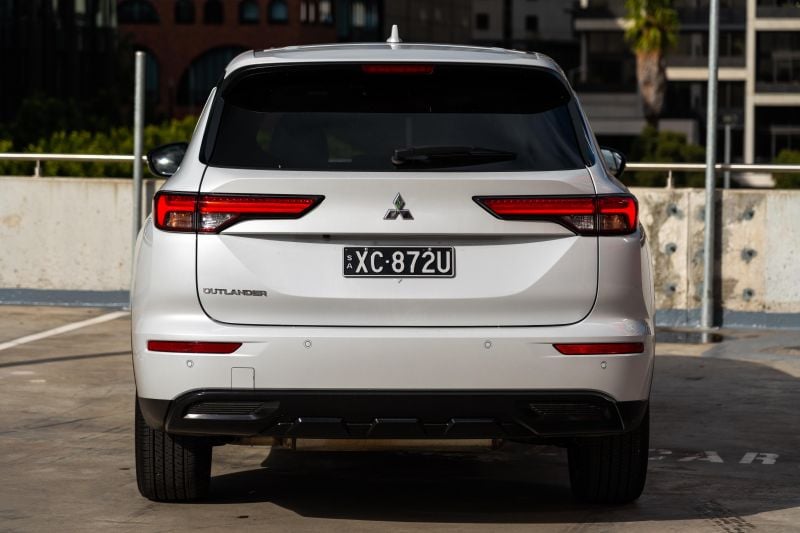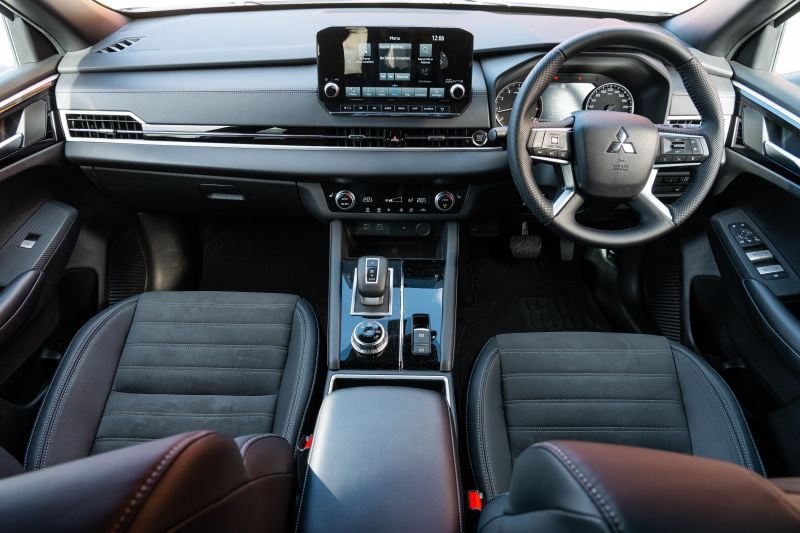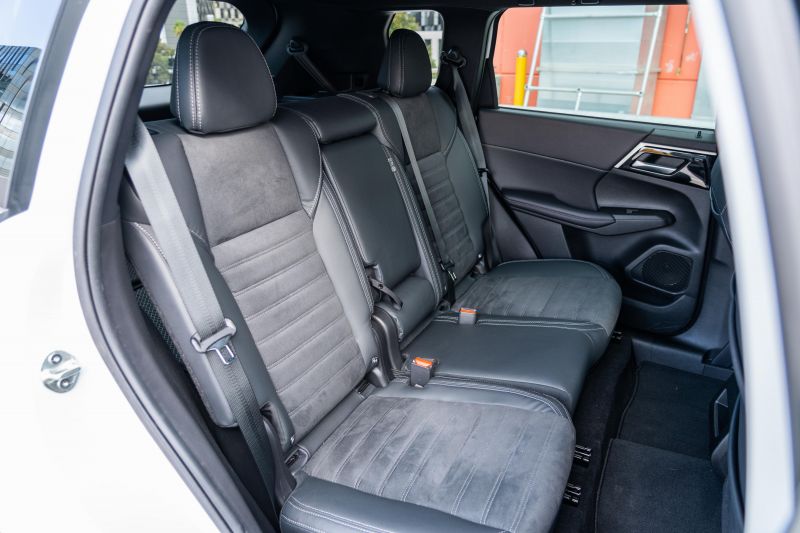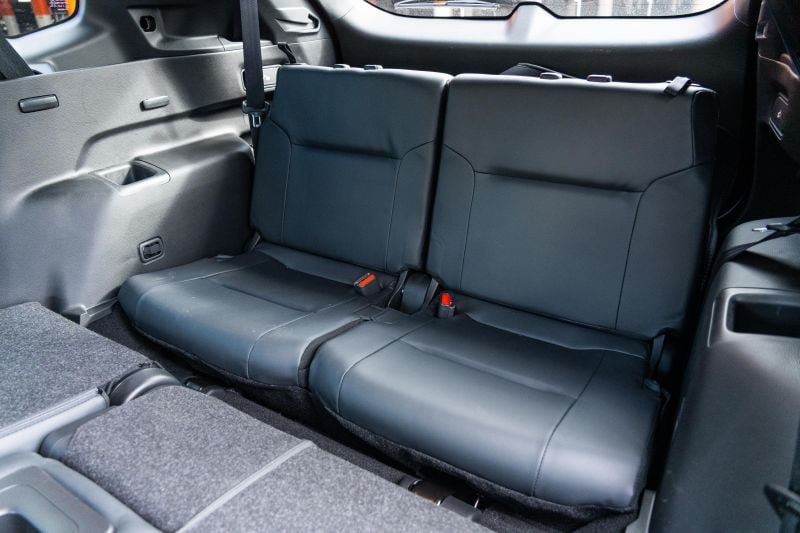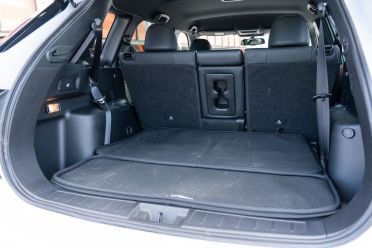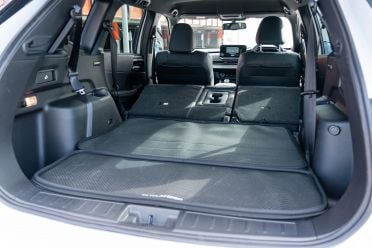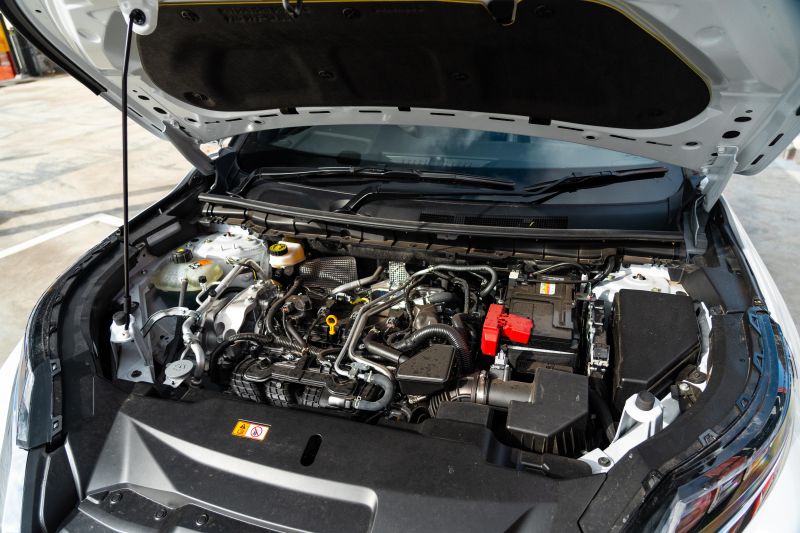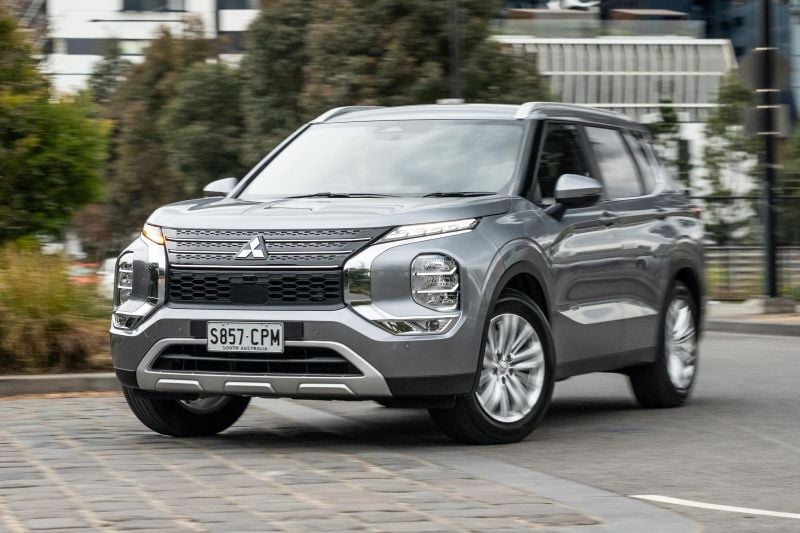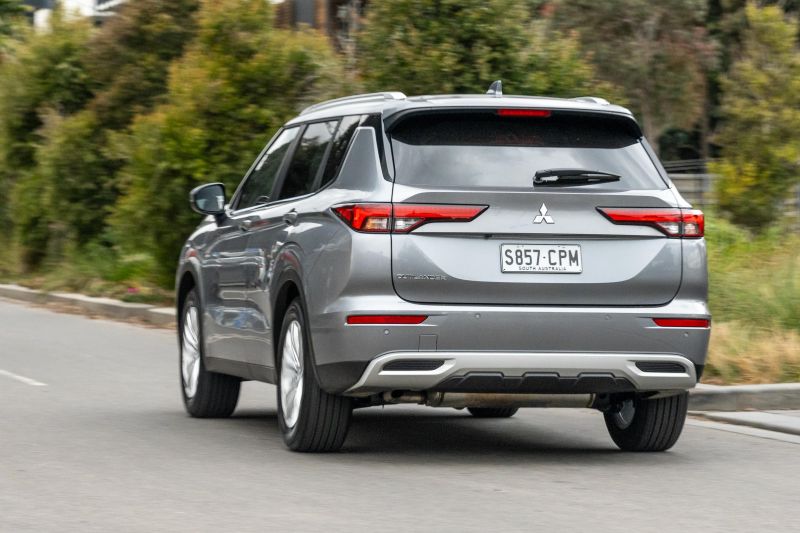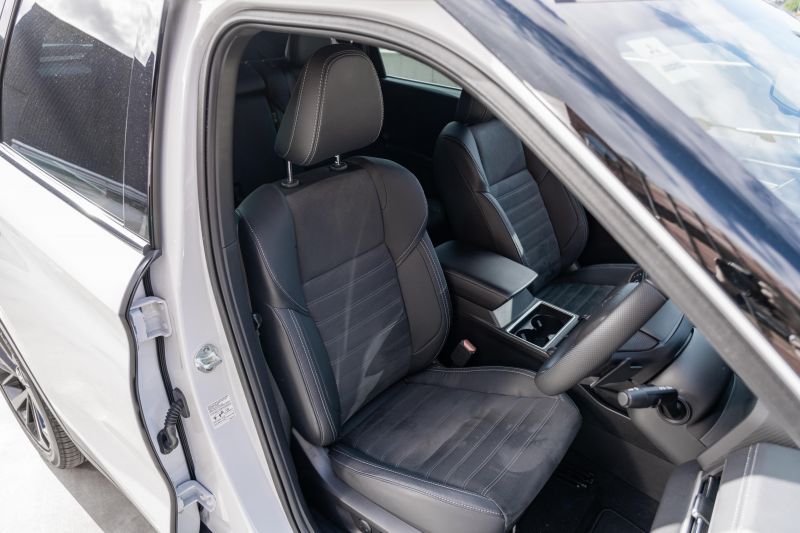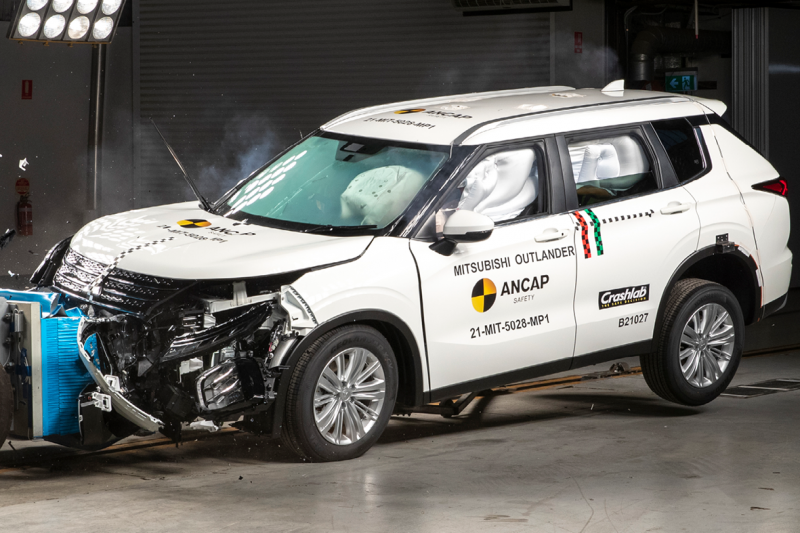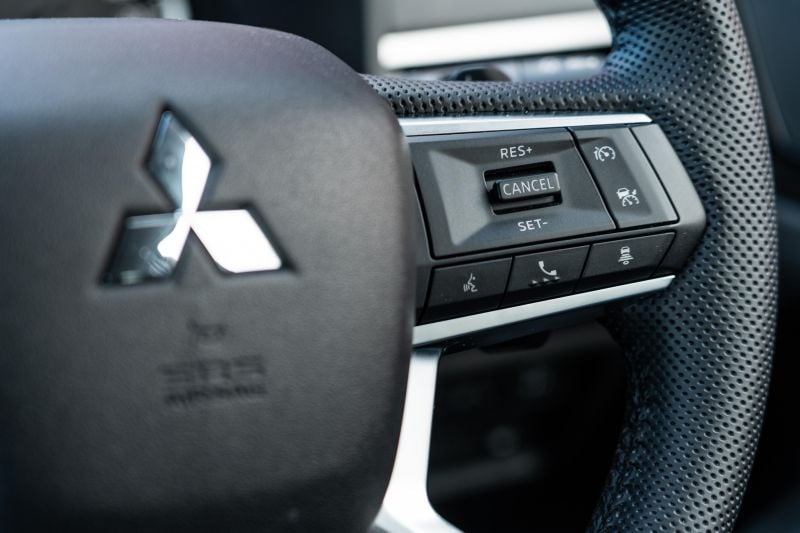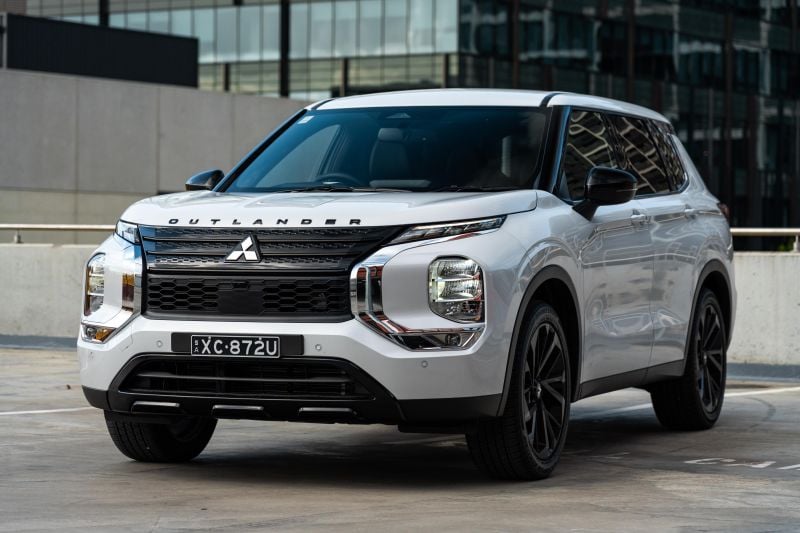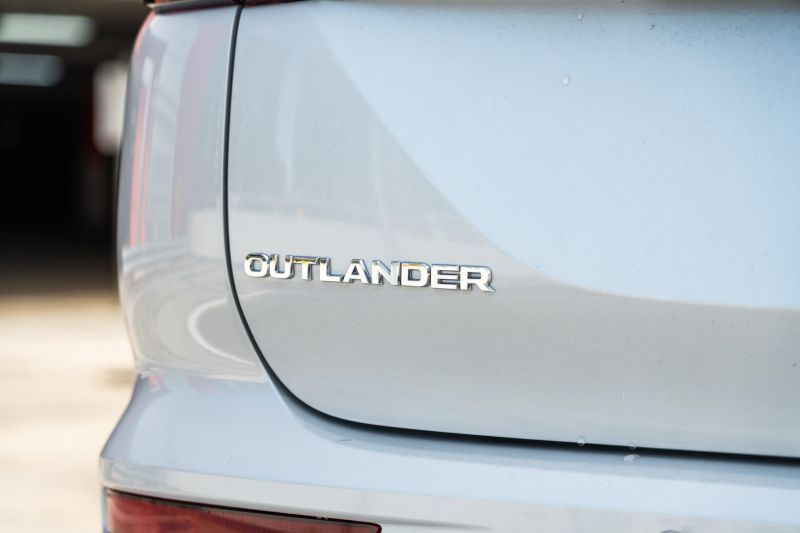Now into its second year on sale, the current-shape Mitsubishi Outlander mid-sized SUV is proving to be a sales hit for the Japanese company.
Around 11,400 of them were delivered in Australia between January and June this year, enough for 11.4 per cent market share – third behind only the Toyota RAV4 and Mazda CX-5, and ahead of the Hyundai Tucson.
The variant we’re driving here, called LS Black Edition, was introduced into the range for the 2023 model year, plugging a gap at the lower end of the line-up. Already an eye-catching design, the LS Black Edition lives up to its name with a range of styling additions.
Eye-catching design is not a trait for which previous iterations of Outlander were synonymous, but this new one certainly turns heads. It has street presence, even from its more polarising angles.
How much does the Mitsubishi Outlander LS Black Edition cost?
The LS Black Edition costs $42,490 before on-road costs, positioning it between the LS ($39,740) and Aspire ($43,240) variants with the same seven-seat layouts. Think of it as a rung above the fleet-focused ES with some sporty design bits added on for added effect.
This list price equates to a drive-away price of about $47,000, which in today’s environment is pretty reasonable.
Because the Outlander as tested offers an occasional-use third row, it’s technically a seven-seater, unlike the aforementioned RAV4, CX-5 and Tucson.
Some of its closest competitors that offer similar levels of versatility for the cost include the mechanically related Nissan X-Trail ST or ST-L (the Outlander slots right between them price-wise) and Honda CR-V VTi 7+ Luxe.
While it’s classified in a smaller market segment by industry sales database VFACTS, we’d also look closely at vehicles such as the base Hyundai Santa Fe, Mazda CX-8 Sport, and Volkswagen Tiguan Allspace 110TSI Life.
2023 Mitsubishi Outlander pricing:
Front-wheel drive (2WD):
- Outlander ES 5-seat: $37,240
- Outlander LS 7-seat: $40,740
- Outlander LS Black Edition 7-seat: $42,490
- Outlander Aspire 7-seat: $44,240
All-wheel drive (4WD):
- Outlander ES 5-seat: $39,740
- Outlander LS 7-seat: $43,240
- Outlander Aspire 7-seat: $46,740
- Outlander Exceed 7-seat: $51,990
- Outlander Exceed Tourer 7-seat: $54,490
Plug-in Hybrid EV 4WD:
- Outlander PHEV ES 5-seat: $56,490
- Outlander PHEV Aspire 5-seat: $62,990
- Outlander PHEV Exceed 7-seat: $68,490
- Outlander PHEV Exceed Tourer 7-seat: $70,990
Prices exclude on-road costs
What is the Mitsubishi Outlander LS Black Edition like on the inside?
This is a major improvement on the old car, and a real selling point.
The proximity key fob unlocks the car when you grab the handle, and the side mirrors unfurl of their own accord. The microsuede and faux leather seats feel good quality and are acceptably comfortable, and the driver’s seat moves electrically.
That steering wheel has stylish perforated leather hand grips, and sensible buttons and rollers on each spoke – audio controls and trip computer menu selector on the left, cruise controls and phone/voice functions on the right.
This variant misses out on the full-width digital cluster with swish graphics as well as a head-up display found further up the range (Aspire and Exceed), instead using simple analogue gauges bookending a smaller display with digital speedo.
The prominent landscape-oriented 9.0-inch touchscreen has handy shortcut buttons below and uses simple tiles and menus. It offers good graphics, sat-nav, and phone mirroring – including wireless CarPlay for Apple users. There’s also a rubberised wireless charger below the climate controls.
While a surround-view monitor is available further up the range, this Outlander grade has a reverse-view camera only. Front and rear occupants get USB ports, both USB-A and USB-C.
The dual-zone climate control is operated by buttons and dials rather than touchscreen menus – excellent choice, Mitsubishi – while the transmission tunnel houses a stubby by-wire shifter, electric park brake, and Auto Hold button to stop you creeping forward in traffic when off the brakes in Drive.
We’re generally not a fan of the glossy piano-like trim piece though, which is an absolute magnet for dust, scratches, smudges and sun glare.
Storage-wise there’s a decent-sized centre console and glovebox, bottle holders in the doors, and slim open sections next you each front occupant’s knee along the centre tunnel.
Overall build quality is pretty good, and there are a lot of padded touchpoints and a few contrasting trim pieces to liven up the ambience. However there are also signs of cost-cutting, for example the door cards are quite flimsy.
The middle row of seats slide and recline a few degrees, and the flat-ish floor makes the middle position more useful. I’m 194cm and had good amounts of leg- and knee room, but head room is only just acceptable due to the raised bench.
Second-row occupants get big windows, their own vents (but no temperature controls at this spec level), and USB ports, plus the centre section tumbles downwards and offers a pair of cupholders.
Access to the third row from the kerbside comes via a slide-and-tilt middle bench section, but be aware that this third row is really only for kids or very occasional use. Handy to have sure, but this is a ‘5+2’ seater rather than a full seven-seater a-la the Toyota Kluger or Hyundai Palisade.
At 4710mm long, the Outlander is a fair bit longer than many other medium SUVs (as classified by VFACTS) – about mid-way between a Toyota RAV4 and a Hyundai Santa Fe.
Fortunately these sixth and seventh seats stow away neatly into the floor, with the headrests removed and stowed under the loading area separately. Boot space with five seats in use is a decent 478 litres, only 7L less than the ES five-seater.
However the ES gets a full-size spare tyre whereas the ‘5+2+ seater models like our test car make do with a skinny space-saver spare. Cargo space behind the third-row of seats when they’re in use is a claimed 163L.
Dimensionally, the boot with the first two rows of seats in operation is 974mm long and 870mm tall, with 1070mm of width between the arches (the narrowest point).
Fold down the middle-row seats via levers in the boot and you get a Bunnings-friendly 1.7-metre loading floor.
What’s under the bonnet?
There’s just the one engine available across all non-PHEV Outlander variants.
It’s a 2.5-litre naturally-aspirated four-cylinder petrol (91 RON) producing 135kW at 6000rpm and 244Nm at 3600rpm, mated to a CVT automatic transmission with paddle shifters.
The LS Black Edition driven here comes as front-wheel drive only, but those who want an on-demand AWD system can opt for this in other variations for a $2500 impost.
Mitsubishi claims fuel consumption on the combined cycle of 7.7 litres per 100km. The fuel tank holds 55 litres. The braked-trailer towing capacity is listed as 1600kg with a 160kg towball load maximum.
How does the Mitsubishi Outlander LS Black Edition drive?
There’s nothing particularly interesting about the way this variant of Outlander drives, and no performance updates to match the stylistic rizz.
The engine’s outputs are solid but not spectacular, and peak power comes on stream quite high in the rev band which means it’s raspier when overtaking. At least it doesn’t overwhelm the front wheels and cause axle tramping.
The CVT is quite a good application as far as these things go, given it doesn’t simply flare and hold revs without adding appreciable forward momentum.
There is a rotary dial on the transmission tunnel that cycles through different drive modes which tweak the drivetrain and traction controls for certain surfaces, and subtly change the throttle mapping to suit slower or faster initial response.
I averaged fuel efficiency of 8.5 litres per 100km, which is respectable but not a match for a hybrid or diesel of any type, really.
While front-wheel drive is ideal for urban commuting, and saves both weight and cost, the added versatility and soft-road capability you access by opting for Mitsubishi’s on-demand AWD system should be taken into account.
While the engine is acceptable without being overly blessed with low-end torque, the ride quality is below par.
Those large wheels and low-profile Bridgestone Ecopia tyres, in conjunction with the damper tune, mean potholes and other road imperfections are felt inside the cabin much more than they should be.
The electric power steering is light and doesn’t deliver much in the way of feel, while the prominent bonnet-lines make the Outlander feel all of its size on the road.
For those who want an Outlander with a more impressive drivetrain, consider the PHEV (plug-in hybrid), but be prepared to fork out a lot more.
The active safety systems are typical for the class with the exception of the lane-keeping aid which relies on haptic alerts and selective wheel braking rather than steering intervention.
What do you get?
The Outlander LS Black Edition echoes the specs of the LS with a few cosmetic additions, listed in bold – though oddly, it loses the regular LS’ roof rails.
- 20-inch black alloy wheels
- Gloss black skid plates
- Gloss black side mirrors
- Gloss black grille garnish
- Black front pillar trims
- Space-saver spare wheel
- LED headlights and DRLs
- Dusk-sensing headlights
- Rain-sensing wipers
- Front and rear parking sensors
- Auto-folding, heated side mirrors
- Proximity-sensing key fob
- Rear privacy glass
- Rear spoiler
- Colour options:
- Red Diamond
- Titanium
- White Diamond – $200 extra
- Black Diamond – $200 extra
- Button-operated start
- Leather-wrapped steering wheel
- Microsuede seats, synthetic leather bolsters
- Powered driver seat adjustments
- Black headlining
- Auto-dimming rear-view mirror
- Dual-zone climate control, rear vents
- 9.0-inch touchscreen
- Satellite navigation
- Apple CarPlay – wireless
- Android Auto – wired
- Wireless phone charger
- 6-speaker audio system
- DAB/FM/AM radio
- Bluetooth streaming
- 4 x USB ports
- Reversing camera
Our test vehicle came with a few Mitsubishi accessories including ‘OUTLANDER’ lettering on the bonnet ($202), floor mats ($216), and a mat liner for the cargo area ($372).
Is the Mitsubishi Outlander LS Black Edition safe?
The Outlander should do a good job keeping your family safe.
It carries a 2022 five-star ANCAP safety rating with scores of 83 per cent for adult occupant protection, 92 per cent for child occupants, 81 per cent for pedestrians and cyclists, and 83 per cent for safety assist aids.
Standard safety features include:
- 8 airbags
- Dual front
- Dual front-side airbags
- Dual side curtain airbags
- Driver’s knee airbag
- Front-centre airbag
- 2 x ISOFIX and 3 x top tethers
- Autonomous emergency braking
- Forward, Reverse
- Pedestrian detection
- Blind-spot monitoring
- Rear cross-traffic alert
- Lane departure warning
- Steering vibration
- Selective braking
- Driver attention alert
- Traffic sign recognition
- Adaptive cruise control
- Auti high-beam
How much does the Mitsubishi Outlander LS Black Edition cost to run?
Mitsubishi provides a standard five-year, 100,000km warranty. However, if you service your vehicle at a Mitsubishi dealership this extends to a 10-year or 200,000km warranty – which is market-leading in terms of timespan.
You’re covered by a 12-month roadside assist plan including Club Membership when you drive off the lot.
Outlander service pricing:
- 1 year or 15,000km: $299
- 2 years or 30,000km: $349
- 3 years or 45,000km: $299
- 4 years or 60,000km: $349
- 5 years or 75,000km: $299
- 6 years or 90,000km: $649
- 7 years or 105,000km: $299
- 8 years or 120,000km: $649
- 9 years or 135,000km: $299
- 10 years or 150,000km: $849
As you can see, it’s quite cheap to maintain for the first five years, before more substantial work needs to be paid for.
CarExpert’s Take on the Mitsubishi Outlander LS Black Edition
The Mitsubishi Outlander is a more sophisticated bit of kit than the old model, particularly inside, and there’s no doubt this LS Black Edition turns a lot of heads.
While it’s not really a bargain any longer, it’s still a lot of well-specified family SUV for the money in today’s context, and comes with a long warranty if you pledge to return to the dealer for servicing.
As a low-frills medium SUV it does a good job, but don’t expect much in the way of driving excitement – the AWD models and particularly the PHEVs are better in this aspect. We’d also like a smoother ride, come facelift time.
Shortlist the Outlander, but make sure you also do your homework and check out a few competitors. Because this is the most tight-fought of all market segments, and the array of choice gives you a key buyer advantage.
Click the images for the full gallery

